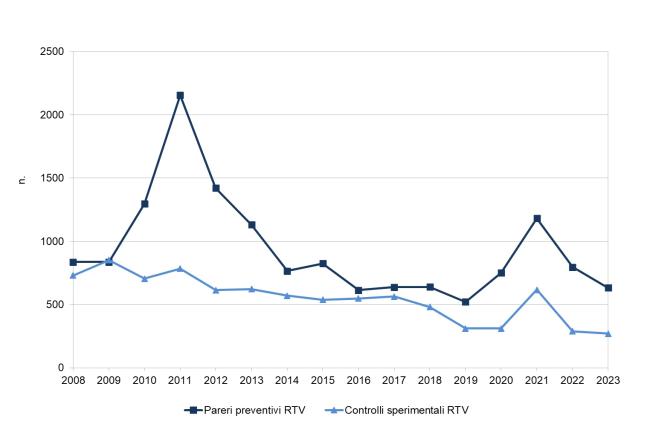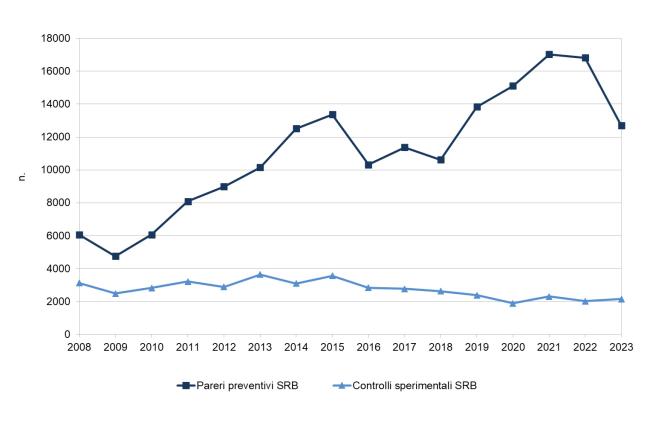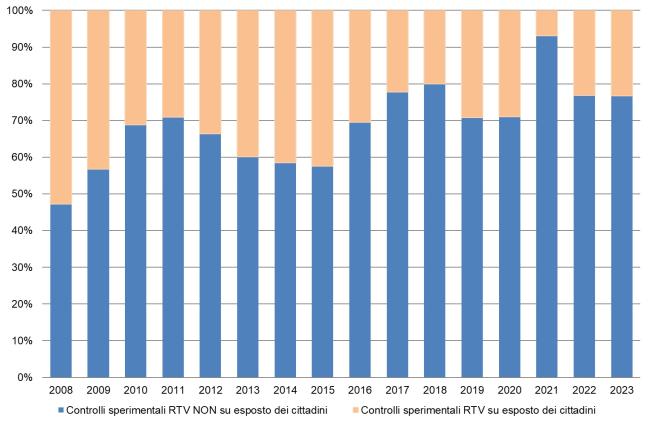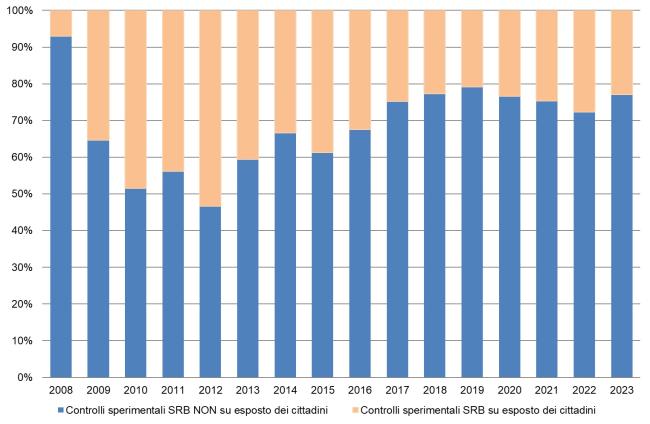Panel 1
Gabriele Bellabarba, Maria Logorelli
The indicator describes the activities carried out by regional environmental protection agencies (ARPA)/ provincial environmental protection agencises (APPA)in terms of preliminary opinions and inspections conducted using measuring instruments on Radio Frequency (RF) sources, distinguishing between radio and television installations (RTV) and base transceiver station for mobile communication (BTS).
In 2023, the number of preliminary opinions issued by ARPA/APPA for RTV installations was 633, showing a significant decrease (-20.5%) compared to 2022. In the same year, the number of inspections for BTSs saw a slight increase of 6.3%, rising from 2,012 to 2,139 compared to the previous year.
Citizen requests for inspections through formal complaints are tending to decline, suggesting a perception of reduced social pressure, even for an electromagnetic source like the Base Transceiver Station, which in the past had raised significant concerns.
The indicator describes the activities carried out by ARPA/APPA in terms of preliminary opinions and inspections conducted using measuring instruments on high-frequency (RF) sources, distinguishing between radio and television installations (RTV) and base transceiver station for mobile communication (BTS).
It also includes information on the number of manual broadband measurements and monitoring campaigns conducted by ARPA/APPA near RTV and BTS installations, as well as the electric field values present in the environment in the presence of such electromagnetic sources.
Quantify the response to the regulatory question regarding the control and supervision activities on radio frequency (RF) installations (RTV and BTS).
Framework Law No. 36/2001 and DPCM 08/07/2003 (RF) and subsequent amendments; Legislative Decree 259/2003 and subsequent amendments.
The control activity, both during the authorization phase and the operation of the installation, aims to ensure compliance with exposure limits, attention values, and quality objectives for the protection of the population, as defined by DPCM 08/07/2003 and its subsequent amendments. Legislative Decree 259/2003 and its subsequent amendments serve as the current regulatory reference governing the authorization procedures for telecommunication installations.
Panel 2
ISPRA, anni vari, Annuario dei dati ambientali
ISPRA, Reports tematici
The information related to the control activities carried out by ARPA/APPA naturally has broader spatial and temporal coverage compared to the data on the number of installations/services and RTV/BTS sites, which are not directly managed by the aforementioned Agencies and are instead provided by the operators of the installations in question.
However, critical issues remain, primarily concerning the availability of local data collection tools (databases, registries) and the limited human resources within ARPA/APPA dedicated to this metadata collection activity.
Synergistic actions by the involved parties to support the flow of information through appropriate regulatory tools and targeted activities aimed at analyzing the aforementioned critical issues, with the goal of shedding light on the problems and proposing solutions to enhance the uniformity and completeness of data at the national level.
Data quality assessment
Electromagnetic Fileds Observatory
14/20
2008-2023
Indicator assessment
Calculation of the total number of controls for RTV installations and BTSs across the national territory. Calculation of the total number of preliminary opinions for RTV installations and BTSs across the national territory
Considering the data provided by ARPA/APPA representatives for 2023 (Tables 1 and 4), it is evident that for BTS installations, the number of issued preliminary opinions and experimental controls conducted (15,887 and 2,796, respectively) is significantly higher than those related to RTV installations (668 and 287, respectively). Among the experimental controls conducted on BTS installations, approximately 31.1% were carried out at the request of citizens, whereas for RTV installations, this percentage accounts for 24% of the total experimental controls. The above calculations consider only those regions/autonomous provinces that provided updated and complete data for 2023 for both types of sources (RTV and BTS): Piedmont, Aosta Valley, Lombardia, Trentino-Alto Adige, Friuli Venezia Giulia, Liguria, Emilia-Romagna, Tuscany, Umbria, Lazio, Abruzzo, Molise, Campania, Apulia, and Sicily.
For the trend analysis, the regions/autonomous provinces considered were those that provided complete data for the period 2008–2023 for both RTV and BTS sources, as well as those for which missing information could be supplemented using relevant data from the previous year or, if unavailable, from the first subsequent year with available data (Piedmont, Aosta Valley, Lombardia, Trentino-Alto Adige, Veneto, Friuli Venezia Giulia, Liguria, Emilia-Romagna, Tuscany, Umbria, Marche, Abruzzo, Puglia, and Basilicata).
For RTV, there was a substantial increase in preliminary opinions from 2008 to 2011, rising from 836 to 2,155 (+158%), likely due to the transition from analog to digital technology, followed by a significant decline until 2019 (-75.8% compared to 2011). In 2020, there was a considerable increase (+44%), which continued in 2021 (+57.6%). However, in 2023, a significant decrease of 46.4% compared to 2021 was recorded (Figure 1).
For BTS, except for 2009, there was a steady increase in preliminary opinions issued by ARPA/APPA from 2008 to 2015, rising from 6,050 to 13,367 (+121%). In 2016, there was a decline (-22.8%) compared to the previous year, likely due to the authorization simplifications introduced by current regulations. From 2016 to 2018, the trend remained relatively stable, followed by a steady increase from 2018 to 2021 (+60.4%), growing from 10,620 to 17,031. However, from 2021 to 2023, a significant decrease of 25.5% was observed (Figure 2).
Regarding experimental controls, RTV showed a highly variable trend from 2008 to 2011, followed by an overall decrease of 60.3% until 2019, dropping from 784 to 311. The number of experimental controls remained stable from 2019 to 2020, with a notable increase in 2021 (+98.4%) compared to 2020 (from 311 to 617), in line with the significant rise in preliminary opinions issued for these installations. However, from 2021 to 2023, there was a substantial decrease in experimental controls (-56.2%), from 617 to 270 (Figure 1).
For BTS, the number of controls fluctuated between a maximum of 3,638 in 2013 and a minimum of 1,886 in 2020. In 2023, a 7.2% decrease was recorded compared to 2021, declining from 2,306 to 2,139 (Figure 2).
Regarding the percentage of controls conducted by ARPA/APPA following citizen reports relative to total controls for RTV, a generally decreasing trend was observed from 53% in 2008 to 7% in 2021, followed by an increase in 2023 to approximately 23% (Figure 3). For BTS, this percentage significantly increased from 7% in 2008 to 53% in 2012 before gradually declining to around 23% in 2023 (Figure 4).
Data
Table 1: Assessments and inspections of broadcasting (RTV) facilities in Italy (2023)
ISPRA elaborations based on ARPA/APPA data (EMF Observatory)
a In experimental inspections, the values in parentheses indicate those carried out upon request, where such information is available.
b The data have not been updated by the regional contact point.
c The national total refers to regions for which the data are complete and up to date.
d Region/autonomous province that provided complete and updated data for both types of electromagnetic sources (RTV and BTS) for the year 2023, and was therefore included in the national comparative calculation.
nd: data not available.
*the data do not cover the entire regional territory.
Table 2: Number of broadband manual measurements and monitoring campaigns conducted in the presence of broadcasting (RTV) installations in 2023
ISPRA elaborations based on ARPA/APPA data (EMF Observatory)
a The data have not been updated by the regional contact point.
b The national total refers to regions for which the data are complete and up to date.
c The total number of measurements and related statistics are cumulative for both RTV and BTS sources.
*the data do not cover the entire regional territory.
nd: data not available.
Table 3: Percentages of broadband manual measurements and monitoring campaigns conducted in the presence of broadcasting (RTV) installations in 2023, with electric field values categorized into four intervals: 3 V/m, 3–6 V/m, 6–20 V/m, ≥ 20 V/m
ISPRA elaborations based on ARPA/APPA data (EMF Observatory)
a The data have not been updated by the regional contact point.
b The total number of measurements and related statistics are cumulative for both RTV and BTS sources.
*the data do not cover the entire regional territory.
nd: data not available.
Table 4: Assessments and inspections of base station (BTS) installations in Italy (2023)
ISPRA elaborations based on ARPA/APPA data (EMF Observatory)
a In experimental inspections, the values in parentheses indicate those carried out upon request, where such information is available.
b The data have not been updated by the regional contact point.
c The national total refers to regions for which the data are complete and up to date.
d Region/autonomous province that provided complete and updated data for both types of electromagnetic sources (RTV and BTS) for the year 2023, and was therefore included in the national comparative calculation.
Table 5: Number of broadband manual measurements and monitoring campaigns conducted in the presence of base station (BTS) installations in 2023
ISPRA elaborations based on ARPA/APPA data (EMF Observatory)
a The data have not been updated by the regional contact point.
b The total number of measurements and related statistics are cumulative for both RTV and BTS sources.
c The national total refers to regions for which the data are complete and up to date.
nd: data not available.
Table 6: Percentages of broadband manual measurements and monitoring campaigns conducted in the presence of base station (BTS) installations in 2023, with electric field values categorized into four intervals: 3 V/m, 3–6 V/m, 6–20 V/m, ≥ 20 V/m
ISPRA elaborations based on ARPA/APPA data (EMF Observatory)
a The data have not been updated by the regional contact point.
b The total number of measurements and related statistics are cumulative for both RTV and BTS sources.
nd: data not available.
Figure 1: Number of preliminary assessments and experimental inspections carried out on broadcasting (RTV) installations
ISPRA elaborations based on ARPA/APPA data (EMF Observatory)
For the above-mentioned trend, only those regions/autonomous provinces that provided complete data for the 2008–2023 period for both types of sources (RTV and BTS) were considered, as well as those for which missing information could be supplemented using relevant data from the previous year or, if unavailable, from the earliest subsequent year with available data.
Figure 2: Number of preliminary assessments and experimental inspections carried out on base station (BTS) installations
ISPRA elaborations based on ARPA/APPA data (EMF Observatory)
For the above-mentioned trend, regions/autonomous provinces that provided complete data for the 2008–2023 period for both types of electromagnetic sources (RTV and BTS) were considered, as well as those for which missing information could be integrated using relevant data from the previous year or, if unavailable, from the first subsequent year with available data.
Figure 3: Number of experimental inspections carried out on broadcasting (RTV) installations, distinguishing between those conducted in response to citizen reports and those not initiated by citizen reports
ISPRA elaborations based on ARPA/APPA data (EMF Observatory)
For the above-mentioned trend, regions/autonomous provinces that provided complete data for the period 2008–2023 for both types of electromagnetic sources (RTV and BTS) were considered, as well as those for which missing data could be integrated using relevant information from the preceding year or, if unavailable, from the first subsequent year with available data.
Figure 4: Number of experimental inspections carried out on base station (BTS) installations, distinguishing between those conducted in response to citizen reports and those not initiated by citizen reports
ISPRA elaborations based on ARPA/APPA data (EMF Observatory)
For the above-mentioned trend, regions/autonomous provinces that provided complete data for the 2008–2023 period for both types of electromagnetic sources (RTV and BTS) were considered, as well as those for which missing information could be supplemented using relevant data from the previous year or, if unavailable, from the earliest subsequent year with available data.




BTS sources undergo more extensive monitoring by ARPA/APPA compared to RTV installations, primarily due to their operational characteristics, which require widespread territorial distribution, especially in urban areas. Based on the data (Tables 1, 2, and 3), control activities continue despite the stabilization or slowdown in new installations, as agencies strive to monitor critical situations and meet citizens' demands for oversight of these electromagnetic sources.
To assess the electric field levels in the presence of RTV and BTS installations, regional data on measurements conducted during ARPA/APPA control activities in 2023 were collected. These results, presented in Tables 3 and 6, are expressed as percentages of manual broadband measurements and monitoring campaigns conducted in 2022, categorized into four electric field intensity ranges: <3 V/m, 3–6 V/m, 6–20 V/m, and ≥20 V/m. This information provides a valuable comparison between RTV and BTS sources regarding their electromagnetic field emissions in the environment.
Analyzing the electromagnetic field levels recorded by ARPA/APPA, RTV installations appear to have a greater impact in terms of non-compliance situations compared to BTS. In regions where more manual broadband measurements and monitoring campaigns were conducted, the data on environmental electric field levels better represent the territorial reality.
The social impact related to public perception of risk from electromagnetic fields emitted by RTV and BTS sources remains significant in both cases. This is evident from the percentage of citizen-requested controls relative to total controls (31% for BTS and 24% for RTV). The extensive control activities conducted by ARPA/APPA over the years have significantly helped mitigate public alarm over the presence of these installations and concerns about exposure to electromagnetic fields.